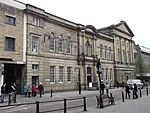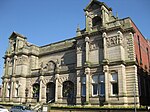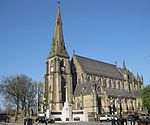
Earl of Derby is a title in the Peerage of England. The title was first adopted by Robert de Ferrers, 1st Earl of Derby, under a creation of 1139. It continued with the Ferrers family until the 6th Earl forfeited his property toward the end of the reign of Henry III and died in 1279. Most of the Ferrers property and the Derby title were then held by the family of Henry III. The title merged in the Crown upon Henry IV's accession to the throne in 1399.

Bury is a large market town in Greater Manchester, England, on the River Irwell 5.5 miles (8.9 km) east of Bolton, 5.9 miles (9.5 km) southwest of Rochdale and 7.9 miles (12.7 km) northwest of Manchester. Bury is the administrative centre of the Metropolitan Borough of Bury, and had a population of 78,723 in 2015; the borough had a population of 187,474 in 2011.
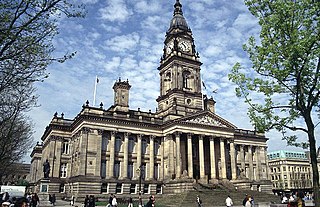
Bolton is a large town in Greater Manchester in North West England, historically and traditionally a part of Lancashire. A former mill town, Bolton has been a production centre for textiles since Flemish weavers settled in the area in the 14th century, introducing a wool and cotton-weaving tradition. The urbanisation and development of the town largely coincided with the introduction of textile manufacture during the Industrial Revolution. Bolton was a 19th-century boomtown and, at its zenith in 1929, its 216 cotton mills and 26 bleaching and dyeing works made it one of the largest and most productive centres of cotton spinning in the world. The British cotton industry declined sharply after the First World War and, by the 1980s, cotton manufacture had virtually ceased in Bolton.

Edward Smith-Stanley, 12th Earl of Derby PC, usually styled Lord Stanley from 1771 to 1776, was a British peer and politician of the late eighteenth and early nineteenth centuries. He held office as Chancellor of the Duchy of Lancaster in 1783 in the Fox–North coalition and between 1806 and 1807 in the Ministry of All the Talents.
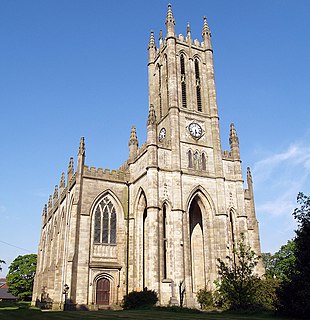
Whitefield is a town in the Metropolitan Borough of Bury, Greater Manchester, England. It lies on undulating ground above the Irwell Valley, along the south bank of the River Irwell, 3 miles (4.8 km) south-southeast of Bury, and 4.9 miles (7.9 km) to the north-northwest of the city of Manchester. Prestwich and the M60 motorway lie just to the south.

Edward George Villiers Stanley, 17th Earl of Derby,, styled Mr Edward Stanley until 1886, then The Hon Edward Stanley and then Lord Stanley from 1893 to 1908, was a British soldier, Conservative politician, diplomat, and racehorse owner. He was twice Secretary of State for War and also served as British Ambassador to France.
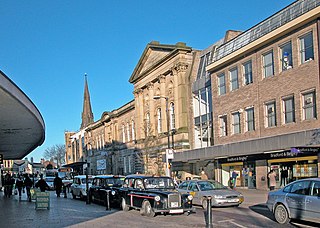
The Met is a performing arts venue in Bury, Greater Manchester, England. It has two theatre spaces and a café bar.
Sydney Smirke was a British architect.

Radcliffe is a market town in the Metropolitan Borough of Bury, Greater Manchester, England. Historically a part of Lancashire, it lies in the Irwell Valley 2.5 miles (4 km) south-west of Bury and 6.5 miles (10 km) north-northwest of Manchester and is contiguous with Whitefield to the south. The disused Manchester Bolton & Bury Canal bisects the town.

Swinton is a town within the City of Salford in Greater Manchester, England, southwest of the River Irwell, 3.4 miles (5.5 km) northwest of Salford and 4.2 miles (6.8 km) northwest of Manchester, adjoining the towns of Pendlebury and Clifton. In 2014, it had a population of 22,931.

Heaton Park is a municipal park in Manchester, England, covering an area of over 600 acres (242.8 ha). The park includes the grounds of a Grade I listed, neoclassical 18th century country house, Heaton Hall. The hall, remodelled by James Wyatt in 1772, is now only open to the public on an occasional basis as a museum and events venue.
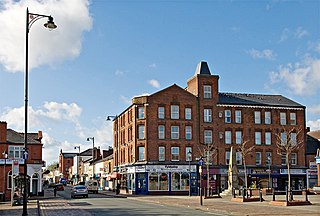
Tyldesley is a town in the Metropolitan Borough of Wigan in Greater Manchester, England, but historically in Lancashire. It is north of Chat Moss near the foothills of the West Pennine Moors, 7.7 miles (12.4 km) southeast of Wigan and 8.9 miles (14.3 km) northwest of Manchester. At the United Kingdom Census 2001, the Tyldesley built-up area, excluding Shakerley, had a population of 16,142.

Breightmet is a neighbourhood of Bolton, in Greater Manchester, England. The population of the ward taken at the 2011 census was 13,584. Historically a township of the civil and ecclesiastical parish of Bolton le Moors in the Salford hundred of Lancashire, it lies 2 miles (3.2 km) north-east of Bolton and 4 miles (6.4 km) north-west of Bury.
The Prescot Playhouse was an Elizabethan theatre in the town of Prescot, which was then in Lancashire. The playhouse was built before 1603, probably in the mid-1590s, and probably remained in theatrical use until 1609. It was one of the few free-standing theatres in England outside London, and probably hosted performances by the playing companies maintained by the Earls of Derby.

Wigan & Leigh College is a state General Further and Higher Education College based at five locations in the towns of Wigan and Leigh in Greater Manchester, England, United Kingdom. Currently, there are 500 staff members employed, and more than 8,000 students enrolled in full-time or part-time courses. The college's programmes of study include: General Certificate of Education (GCSEs), BTEC First Diplomas, A-Levels, National Diplomas, Higher National Diplomas, Apprenticeships, Foundation Degree and Degree courses.
Philips Park is an area of parkland situated within the Metropolitan Borough of Bury on the boundary of Whitefield and Prestwich, in Greater Manchester. The park consists of rich woodland and grassland habitat and is home to an assortment of wildlife. Two thirds of the site was once the Philips family estate, and the remainder, known as Waterdale, is Irwell Valley land reclaimed following the demolition of two bleach and dye works. The park is a local nature reserve.

The Church of St Peter and St Paul is in the market town of Ormskirk, Lancashire, England. Dating from no later than the 12th century, it is one of only three churches in England to have both a tower and spire, and the only one to have them both at the same end of the church. It is an active Anglican parish church in the Diocese of Liverpool. The church is recorded in the National Heritage List for England as a designated Grade II* listed building.

A sculpture of the statesman and three-time Prime Minister of the United Kingdom, Edward Smith-Stanley, 14th Earl of Derby, is located in Parliament Square, London, England. The sculptor was Matthew Noble and the Grade II-listed statue was unveiled on 11 July 1874.

Ann Geraldine Limb is a British educationalist, philanthropist, business leader, and charity chair. In September 2015, she became the first woman Chair of The Scout Association since the organization was founded by Robert Baden Powell in 1907.

Bury Town Hall is a municipal building in Knowsley Street, Bury, Greater Manchester, England.



















